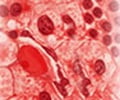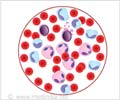Key genetic signature that leads to the development of acute lymphoblastic leukemia in children could be a marker for identification and provide drug targets.
Highlights
- Researchers from St Jude’s Children’s research hospital have identified gene signature for certain pediatric acute lymphoblastic leukemia subtypes.
- Mutation in DUX 4 gene leads to lowered production of the transcription factor ERG that leads to the development of Acute Lymphoblastic Leukemia (ALL).
- This genetic marker can be used to identify high risk patients and also provide new drug targets.
Distinctive Genetic Profile Associated with Acute Lymphoblastic Leukemia
The researchers studied 1913 patients with B precursor lymphoblastic leukemia which included children, young adults and adolescents. 7.6% of these patients had a distinctive genetic profile that prompted further research.
The Chief of the Division of Oncology at the Philadelphia’s Children's Hospital and co-author Dr Stephen Hunger, "These findings explain the genetic defects that underlie a relatively common subset of B-ALL that was not fully understood until the DUX4 abnormalities were discovered. These results underscore that there is still more to be learned about the genetic changes in ALL, and that this knowledge can help refine treatment for patients,"
Mechanism of Development of Leukemia
The sequencing studies carried out by the researchers revealed the following:
- In the subtypes of ALL, there was a rearrangement of the transcription factors gene DUX4.
- This resulted in an increased expression of the gene
- DUX4 binds to the gene that is responsible for the transcription factor ERG
- This lead to a decreased production of ERG
- The lowered level of ERG was due to a deletion of a part of the gene or due to the secretion of another form of ERG, ERGalt
Protein Paint
The genetic structure of this particular variant of BLL is available in a tool that has been developed by the researchers from St Jude that is used to detail cancer mutations in children.
Dr Li Ding who is the assistant director of The McDonnell Genome Institute and director of computational biology at the Washington University School of Medicine’s Division of Oncology noted: "Our data reveal that a genetic rearrangement of DUX4 is present in all cases for patients with the distinct gene expression profile that was identified in our study. The genetic rearrangement of DUX4 is a clonal event that is acquired early in the development of leukemia."
Childhood Acute Lymphoblastic Leukemia
In this type of cancer, the body makes a lot of immature white blood cells. The cancer affects the red blood cells, white blood cells as well as the platelets. In children, the symptoms include fever and bruising.
Acute lymphoblastic leukemia is caused due to certain genetic abnormalities and in adults, previous treatments for cancer have also been implicated.
The identification of the abnormality in the DUX4 gene will aid in better identification of
high risk patients using genetic testing and provide new targets for drug therapy.
References:
- Childhood Acute Lymphoblastic Leukemia Treatment - (https://www.cancer.gov/types/leukemia/patient/child-all-treatment-pdq)
- Acute lymphoblastic leukaemia (ALL) in children - (http://www.macmillan.org.uk/cancerinformation/cancertypes/childrenscancers/typesofchildrenscancers/acutelymphoblasticleukaemia.aspx)














